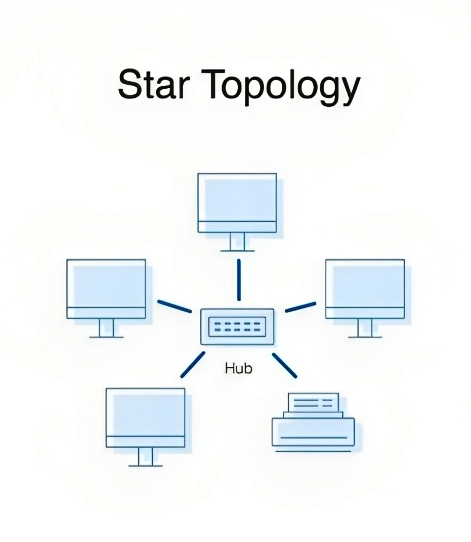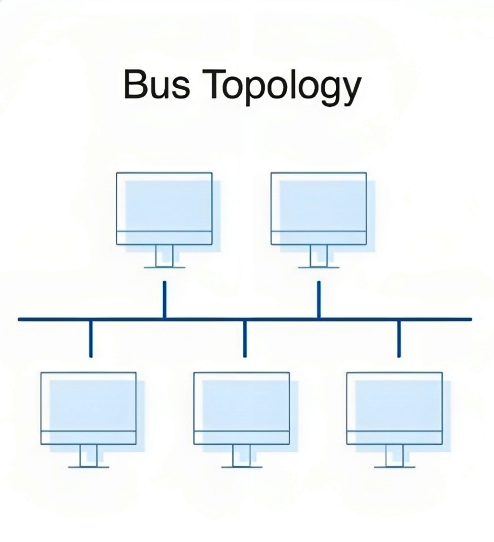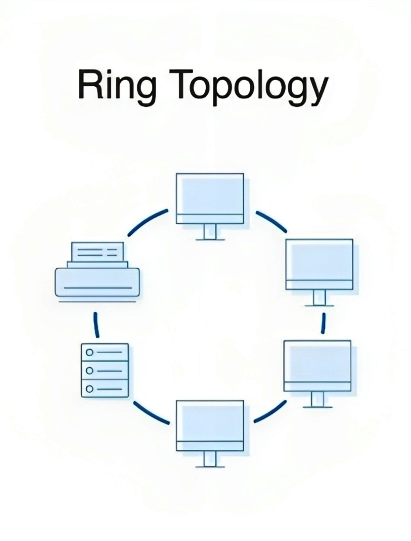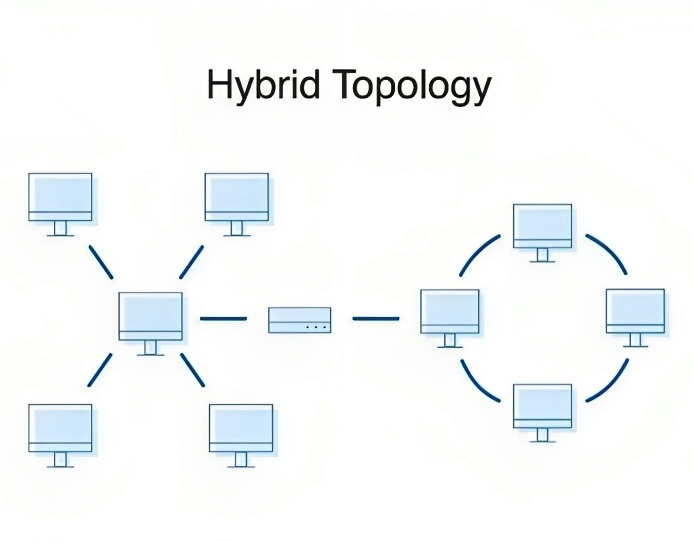What Is Network Topology?
The performance of a network is significantly influenced by its configuration or topology. Network topology refers to how a network is organized, encompassing the physical or logical layout of links and nodes in relation to each other.
There are various ways to organize a network, each with its own set of advantages and disadvantages, and some may be more suitable for specific circumstances than others. Administrators have several options when choosing a network topology, and this decision must take into account the size and scale of their business, its objectives, and budget constraints. Effective network topology management involves multiple tasks, including configuration management, visual mapping, and overall performance monitoring. The key is to understand your objectives and requirements to establish and manage the network topology in the right way for your business.
ad
After providing a comprehensive definition of network topology, this article will explore the main types of network topologies, outlining their benefits and drawbacks, and offering considerations to help determine the most suitable one for your business.
What Is Network Topology?
Network topology refers to the physical or logical arrangement of nodes, devices, and connections within your network in relation to each other. Consider your network as a complex puzzle, and the topology as the pattern that fits all the pieces together. Just as puzzles can be solved in various ways, there are multiple methods to structure a network. Each approach has its own advantages and disadvantages, and depending on your company’s needs, specific arrangements can offer varying levels of connectivity and security.
There are two primary approaches to network topology: physical and logical. Physical network topology deals with the tangible connections and interconnections between nodes and the network, including elements like wires and cables. On the other hand, logical network topology is more abstract and strategic, focusing on the conceptual understanding of why and how the network is organized, and how data flows through it.
ad
Why Is Network Topology Important?
The configuration of your network holds significant importance for several reasons. Primarily, it plays a crucial role in determining the functionality and efficiency of your network. Opting for the appropriate topology based on your company’s operational model can enhance performance, simplify fault location, facilitate error troubleshooting, and optimize resource allocation across the network, promoting overall network health. A well-organized and adequately managed network topology contributes to increased energy and data efficiency, ultimately leading to reduced operational and maintenance costs.
Network design and structure are typically depicted and manipulated in a software-generated network topology diagram. These diagrams serve essential purposes, particularly in providing visual representations of both physical and logical layouts. This visual aid enables administrators to observe device connections during troubleshooting.
The arrangement of a network can significantly impact its functionality, connectivity, and resilience against downtime. The concept of “What is network topology?” can be elucidated by exploring the two categories in network topology:
- Physical – Referring to the actual connections (wires, cables, etc.) that constitute the network’s arrangement, the physical network topology requires insights for tasks such as setup, maintenance, and provisioning.
- Logical – Representing a higher-level idea of the network setup, including the connections between nodes and the transmission of data, logical network topology encompasses virtual and cloud resources.
Effective network management and monitoring necessitate a comprehensive understanding of both the physical and logical topology to ensure the efficiency and health of your network.
What’s the Most Common Type of Network Topology?
Creating a local area network (LAN) topology is a crucial aspect for your business, as it determines the resilience, security, and ease of maintenance of the setup. Various network topology types exist, each suitable for different purposes, depending on the overall network size and your specific objectives. Just like many decisions, there is no one-size-fits-all or definitive “right” option. Keeping this in mind, I will guide you through the typical network topology definitions to provide insights into the advantages and disadvantages of each.
1. Star Topology
In a star topology, the most prevalent network arrangement, each node in the network is directly linked to a central hub through coaxial, twisted-pair, or fiber-optic cables. The central node, acting as a server, oversees data transmission. Information from any node on the network must pass through this central hub to reach its destination. Additionally, the central node functions as a repeater, preventing data loss.

Advantages of Star Topology
Star topologies are widely adopted because they offer convenient management of the entire network from a single location. Each node’s independent connection to the central hub ensures that if one node fails, the rest of the network continues to function unaffected, establishing the star topology as a stable and secure network layout.
Furthermore, devices can be added, removed, or modified without requiring the entire network to go offline. On the physical side, the star topology’s structure utilizes minimal cabling for complete network connectivity, facilitating a straightforward setup and management as the network expands or contracts. The simplicity of the network design also aids administrators in easily identifying errors or performance issues.
Disadvantages of Star Topology
Conversely, if the central hub experiences a malfunction, the rest of the network becomes nonfunctional. However, with proper management and maintenance of the central hub, administrators should encounter minimal issues.
The overall bandwidth and performance of the network are constrained by the central node’s configurations and technical specifications, rendering star topologies expensive to establish and operate.
2. Bus Topology
A bus topology organizes all network devices along a single cable running in one direction from one end of the network to the other, sometimes referred to as a “line topology” or “backbone topology.” Data flow on the network follows the route of the cable, moving in a single direction.

Advantages of Bus Topology
Bus topologies are a cost-effective choice for smaller networks due to their simple layout, allowing all devices to be connected via a single coaxial or RJ45 cable. If needed, additional nodes can be easily added by incorporating more cables.
Disadvantages of Bus Topology
However, because bus topologies rely on a single cable for data transmission, they are somewhat vulnerable. If the cable experiences a failure, the entire network goes down, leading to potentially time-consuming and expensive restoration, which may be less of a concern for smaller networks.
Bus topologies are best suited for small networks as there is limited bandwidth, and each additional node can impede transmission speeds. Furthermore, data transmission is “half-duplex,” meaning it cannot be sent in two opposite directions simultaneously, making this layout less ideal for networks with significant traffic.
3. Ring Topology
Ring topology involves arranging nodes in a circular or ring formation. Data can travel through the ring network in either a unidirectional or bidirectional manner, with each device having precisely two neighbors.

Advantages of Ring Topology
In ring topologies, as data is transmitted, packets travel along the circle, passing through each intermediate node until they reach their destination. Repeating devices can be employed in large ring topologies to ensure correct packet arrival without data loss.
With only one station allowed to send data at a time, the risk of packet collisions is significantly reduced, making ring topologies efficient in transmitting error-free data.
Ring topologies are generally cost-effective and inexpensive to install. The point-to-point connectivity of nodes facilitates the identification of issues or misconfigurations on the network.
Disadvantages of Ring Topology
Despite its popularity, a ring topology is susceptible to failure without proper network management. Since data transmission flows unidirectionally between nodes along each ring, the failure of one node can impact the entire network. Thus, vigilant monitoring and maintenance of each node are crucial. However, even with careful attention to node performance, a transmission line failure can still bring down the network.
Scalability is a consideration, as all devices on the network share bandwidth in a ring topology. The addition of more devices can lead to overall communication delays, requiring network administrators to carefully manage device additions to avoid overburdening resources.
Furthermore, reconfiguring, adding, or removing nodes necessitates taking the entire network offline. While not catastrophic, scheduling network downtime for such adjustments can be inconvenient and costly.
4. Dual-Ring Topology
A network utilizing ring topology operates in a half-duplex mode, allowing data to move in only one direction at a time. To convert ring topologies into full-duplex, a second connection between network nodes is added, resulting in a dual ring topology.
The main advantage of a dual ring topology lies in its efficiency. With each node having two connections on either side, information can be transmitted both clockwise and counterclockwise along the network. The secondary ring in a dual-ring topology serves as a redundant layer and backup, addressing many of the drawbacks associated with traditional ring topologies. Additionally, dual ring topologies enhance security by allowing data transmission even if one ring fails within a node.
5. Tree Topology
The tree topology derives its name from the way the central node acts as a trunk for the network, with nodes extending outward in a branching pattern. However, unlike a star topology where each node directly connects to the central hub, a tree topology exhibits a parent-child hierarchy in how nodes are linked. Nodes connected to the central hub are linearly linked to other nodes, with two connected nodes sharing only one mutual connection. Due to its high flexibility and scalability, the tree topology is commonly employed in wide area networks to support numerous dispersed devices.

Pros of Tree Topology
The incorporation of elements from both star and bus topologies allows for easy node addition and network expansion. Troubleshooting network errors is straightforward, as each branch can be individually assessed for performance issues.
Cons of Tree Topology
Similar to the star topology, the entire network relies on the health of the root node in a tree topology structure. If the central hub fails, the various node branches become disconnected, although connectivity within branch systems is maintained.
Due to the hierarchical complexity and linear structure of the network layout, adding more nodes to a tree topology can rapidly make proper management challenging and costly. The expense of tree topologies is attributed to the extensive cabling required to connect each device within the hierarchical layout.
6. Mesh Topology
Mesh topology is a sophisticated structure of point-to-point connections where nodes are intricately interconnected. Mesh networks can take the form of full or partial mesh, with partial mesh topologies having mostly interconnected nodes, some of which only have two or three connections, while full-mesh topologies are entirely interconnected.

The web-like arrangement of mesh topologies facilitates two distinct methods of data transmission: routing and flooding. In routing, nodes use logic to determine the shortest distance from the source to the destination, whereas flooding involves sending information to all nodes within the network without relying on routing logic.
Advantages of Mesh Topology
Mesh topologies are known for their reliability and stability, and the complex interconnectivity between nodes makes the network resistant to failure. Notably, the network remains operational even if a single device goes offline.
Disadvantages of Mesh Topology
Mesh topologies are highly labor-intensive. Each interconnection between nodes requires cabling and configuration upon deployment, making the setup process time-consuming. Similar to other topology structures, the cumulative cost of cabling can escalate rapidly, and it’s an understatement to say that mesh networks demand a substantial amount of cabling.
7. Hybrid Topology
Hybrid topologies involve the combination of two or more distinct topology structures, with the tree topology serving as a notable example by incorporating both bus and star layouts. These hybrid structures are commonly found in larger companies, especially where individual departments require customized network topologies tailored to their specific needs and usage patterns.
Advantages of Hybrid Topology
The primary advantage of hybrid structures lies in the level of flexibility they offer, as there are few limitations on the network structure that a hybrid setup cannot accommodate.
Disadvantages of Hybrid Topology
Nevertheless, each type of network topology brings its own set of disadvantages, and as a network increases in complexity, the expertise and knowledge required from administrators also grow to ensure optimal functionality. Additionally, there is a monetary cost associated with creating a hybrid network topology.
Which Topology Is Best for Your Network?
No network topology is inherently perfect or superior to others, making the selection of the right structure for your business contingent on your network’s needs and size. Key elements to consider include:
- Length of Cable Needed: Generally, the more cable required in a network topology, the more effort is needed for setup. Bus and star topologies are simpler, being relatively lightweight, while mesh networks are more cable- and labor-intensive.
- Cable Type: Consider the type of cable to be installed. Coaxial and twisted-pair cables use insulated copper or copper-based wiring, while fiber-optic cables are made from thin plastic or glass tubes. Twisted-pair cables are cost-effective but have less bandwidth than coaxial cables. Fiber-optic cables offer high performance but are more expensive to install due to additional components. The choice of wiring depends on your network’s needs, including applications, transmission distance, and desired performance.
- Cost: Installation cost is crucial to account for, especially as more complex network topologies require additional time and funding. Combining different elements, such as connecting a complex network structure with more expensive cables, can compound costs. Selecting the right topology involves balancing installation and operating costs with the desired network performance.
- Scalability: Consider scalability, especially if your company and network are expected to expand. Opting for an easily modifiable network topology, like star topologies, allows for the addition, removal, and alteration of nodes with minimal disruption. In contrast, ring networks require complete downtime for any changes to nodes.
FAQ’s
What is network topology?
Network topology refers to the physical or logical arrangement of nodes, devices, and connections within a network. It encompasses the layout of links and nodes, determining how data flows between them.
Why is network topology important?
The configuration of a network is crucial for determining its functionality and efficiency. Choosing the right topology enhances performance, simplifies fault location, facilitates error troubleshooting, and optimizes resource allocation, ultimately promoting overall network health.
How does physical network topology differ from logical network topology?
Physical network topology deals with tangible connections like wires and cables, while logical network topology is more abstract, focusing on the conceptual understanding of how data flows through the network and why it’s organized in a certain way.
What tasks are involved in effective network topology management?
Effective network topology management includes tasks such as configuration management, visual mapping, and overall performance monitoring. These activities are essential for maintaining an organized and efficient network structure.
Are there specific advantages to using a star topology in a network?
Yes, star topologies are widely adopted because they offer convenient management from a single location. They provide stable and secure network layouts, and devices can be added or modified without requiring the entire network to go offline.
What are the disadvantages of a bus topology?
Bus topologies are vulnerable because they rely on a single cable for data transmission. If the cable fails, the entire network goes down. Additionally, there is limited bandwidth, and each additional node can impede transmission speeds.
How does ring topology ensure error-free data transmission?
Ring topologies transmit data in a unidirectional or bidirectional manner, and repeating devices ensure correct packet arrival without data loss. Only one station can send data at a time, reducing the risk of packet collisions and promoting efficient, error-free transmission.
What is the main advantage of a dual-ring topology?
A dual-ring topology operates in full-duplex mode, allowing data to move in both directions simultaneously. This enhances efficiency, and the secondary ring serves as a redundant layer, addressing drawbacks associated with traditional ring topologies.
In what scenarios is a tree topology commonly employed?
Tree topologies, with their flexibility and scalability, are commonly employed in wide area networks (WANs) to support numerous dispersed devices. The hierarchical structure allows for easy node addition and network expansion.
What distinguishes mesh topology for data transmission?
Mesh topologies are known for their reliability and stability. They involve intricate interconnections between nodes, offering resistance to failure. Data transmission in mesh topologies can occur through routing or flooding methods.
Are there specific challenges associated with hybrid topologies?
While hybrid topologies offer flexibility, they come with challenges. As network complexity increases, administrators need expertise to ensure optimal functionality. Additionally, there is a monetary cost associated with creating a hybrid network topology.
How does the length of cable needed impact network topology selection?
The length of cable needed affects the effort required for setup. Simpler topologies like bus and star are relatively lightweight, while more complex mesh networks are more cable- and labor-intensive.
How does the choice of cable type impact network performance?
The choice of cable type, such as coaxial, twisted-pair, or fiber-optic, affects network performance. Twisted-pair cables are cost-effective but have less bandwidth, while fiber-optic cables offer high performance but are more expensive to install.
Why is scalability an important consideration in network topology selection?
Scalability is crucial, especially if a company and its network are expected to expand. Easily modifiable topologies, like star, allow for minimal disruption during node additions or alterations, ensuring smooth scalability.
How do installation costs factor into network topology selection?
Installation costs are crucial as more complex topologies require additional time and funding. Balancing installation and operating costs with desired network performance is essential in selecting the right topology.
Conclusion
Choosing the right network topology is a critical decision that profoundly influences a network’s efficiency. Whether opting for the simplicity of star or bus configurations or the intricate interconnectivity of mesh and hybrid structures, each topology comes with its own trade-offs. There’s no universal solution, and the decision hinges on the unique needs and scale of a business. Factors like cable length, type, cost, and scalability must be carefully weighed. Effective network topology management, encompassing both physical and logical considerations, is paramount for a robust network. In the ever-evolving tech landscape, selecting the optimal network topology is a strategic move towards ensuring peak performance.
ad


Comments are closed.